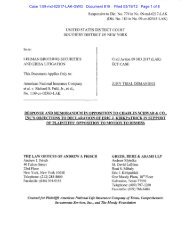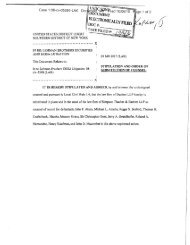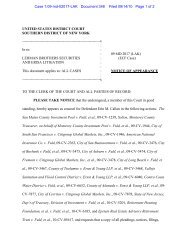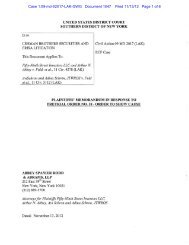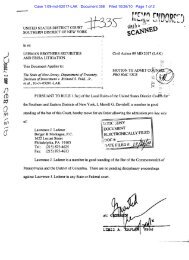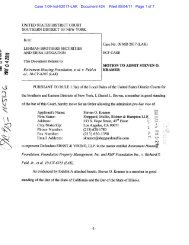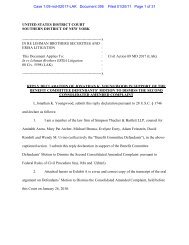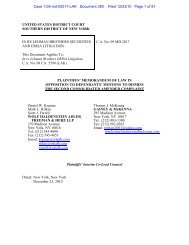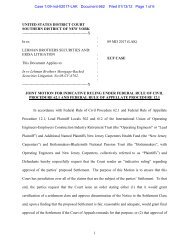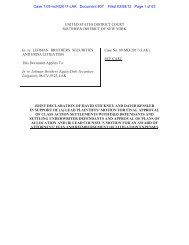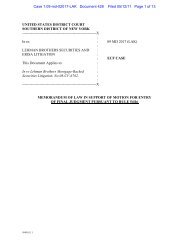disclose that (i) it simultaneously engaged in Repo 105 transactions for tens ofbillions of dollars in assets; (ii) it was recording the Repo 105 transactions as if theunderlying assets had been permanently sold and removed from the books; and (iii) ithad an obligation to repurchase these assets just days after the end of each quarter.This undisclosed practice had the effect of artificially and temporarily reducing<strong>Lehman</strong>’s net leverage ratio each quarter during the Class Period – an importantmetric to securities analysts, credit agencies and investors – rendering <strong>Lehman</strong>’sstatements concerning net leverage and financial condition materially false andmisleading when made and in violation of GAAP.Risk Management: <strong>Lehman</strong> publicly and consistently promoted its robust andsophisticated risk management system. In truth, however, <strong>Lehman</strong> regularlydisregarded and exceeded its risk limits, or simply raised the limits, as <strong>Lehman</strong>accumulated illiquid assets, including the largest in its history – the $5.4 billionArchstone project discussed below.Liquidity: Defendants’ statements concerning <strong>Lehman</strong>’s liquidity failed to disclosethat Repo 105 transactions had the effect of materially understating <strong>Lehman</strong>’sliquidity risk as <strong>Lehman</strong> had tens of billions of dollars in immediate short termobligations that were unreported, and as the Class Period continued, <strong>Lehman</strong>’sreported liquidity pool included large amounts of encumbered assets.Commercial Real Estate Assets: Defendants represented that all of <strong>Lehman</strong>’sassets were presented at “fair value.” <strong>Lehman</strong>, however, failed to consider marketinformation when valuing certain of its commercial real estate assets, therebymaterially overstating their value. Concentration of Credit Risk: GAAP requires disclosure of significantconcentrations of credit risk. <strong>Lehman</strong>, however, failed to disclose material factsconcerning its concentration of mortgage and real estate related assets, preventinginvestors from meaningfully assessing the Company’s exposure to these risky assets.2. In short, as the Examiner recently testified before the House Committee on FinancialServices, “the public did not know there were holes in the reported liquidity pool, nor did it knowthat <strong>Lehman</strong>’s risk controls were being ignored, or that reported leverage numbers were artificiallydeflated. Billions of <strong>Lehman</strong> shares traded on misinformation.”II.JURISDICTION AND VENUE3. This Court has jurisdiction over the subject matter of this action pursuant to Section22 of the <strong>Securities</strong> Act, 15 U.S.C. § 77v; Section 27 of the Exchange Act, 15 U.S.C. § 78aa; and 28U.S.C. § 1331.-2-
4. Venue is proper in this District pursuant to Section 22 of the <strong>Securities</strong> Act,15 U.S.C. § 77v; Section 27 of the Exchange Act, 15 U.S.C. § 78aa; and 28 U.S.C. § 1391(b), (c),and (d). Many of the acts and transactions described herein, including the preparation anddissemination of materially false and misleading public filings, occurred in this District. At alltimes relevant, <strong>Lehman</strong>’s headquarters and principal offices were located in this District.5. In connection with the acts alleged herein, Defendants used the means andinstrumentalities of interstate commerce, including, but not limited to, the United States mails,interstate telephone communications, and the facilities of national securities exchanges.III.PARTIES AND RELEVANT NON-PARTIESA. Plaintiffs6. Court-appointed Lead Plaintiffs Alameda County Employees’ RetirementAssociation (“ACERA”), Government of Guam Retirement Fund (“GGRF”), Northern IrelandLocal Government Officers’ Superannuation Committee (“NILGOSC”), City of Edinburgh Councilas Administering Authority of the Lothian Pension Fund (“Lothian”), and Operating EngineersLocal 3 Trust Fund (“Operating Engineers”), along with the additional plaintiffs identified inAppendices A and B, purchased or otherwise acquired <strong>Lehman</strong> common stock during the ClassPeriod, and/or various <strong>Lehman</strong> securities set forth in Appendices A and B, and were damagedthereby.B. Relevant Non-Parties7. <strong>Lehman</strong>, headquartered in New York, was a global investment bank. <strong>Lehman</strong>’scommon stock traded on the New York Stock Exchange. On September 15, 2008, <strong>Lehman</strong> filed forbankruptcy protection under Chapter 11 of the Bankruptcy Code. For this reason, <strong>Lehman</strong> is notnamed as a defendant in this action.-3-
- Page 2 and 3: TABLE OF CONTENTSI. NATURE OF ACTIO
- Page 4 and 5: COUNT VI Violations Of Section 20A
- Page 6 and 7: CEO:CFO:CLO:CMBS:Commercial Portfol
- Page 8 and 9: SFAS 133:SFAS 140:SFAS 157:Financia
- Page 12 and 13: C. Defendants8. At all relevant tim
- Page 14 and 15: can only be ascertained through app
- Page 16 and 17: A. The Offering Materials Were Mate
- Page 18 and 19: 105 transactions, “[c]onsequently
- Page 20 and 21: Table 3 - Repo 105 Transactions and
- Page 22 and 23: financial condition and operations
- Page 24 and 25: were temporarily removed from Lehma
- Page 27 and 28: purpose to the transactions. Indeed
- Page 29 and 30: management policies and systems ena
- Page 31 and 32: 76. Indeed, in order to engage in r
- Page 33 and 34: Lehman’s stress tests “meaningl
- Page 35 and 36: 3. The Offering Materials Contained
- Page 37 and 38: with regard to Level 3 inputs, SFAS
- Page 39 and 40: and other boom markets, focused on
- Page 41 and 42: specifically carved out “all [of
- Page 43 and 44: Lehman had already committed to fin
- Page 45 and 46: derivative component of the investm
- Page 47 and 48: generally accepted accounting princ
- Page 49 and 50: 119. After Lehman’s bankruptcy, i
- Page 51 and 52: misleading. The Securities Act Defe
- Page 53 and 54: 138. Plaintiffs and other members o
- Page 55 and 56: A. Repo 105 Transactions1. Lehman U
- Page 57 and 58: our governments businesses around t
- Page 59 and 60: 154. As the Examiner stated with re
- Page 61 and 62:
162. The Insider Defendants knew an
- Page 63 and 64:
169. Rather than disclose to the in
- Page 65 and 66:
setting of risk limits.” These st
- Page 67 and 68:
exceeded its risk appetite limits b
- Page 69 and 70:
most part that are in-the-money”
- Page 71 and 72:
y the Company on June 9, Callan sta
- Page 73 and 74:
198. The 2Q08 10-Q reported that th
- Page 75 and 76:
cover lending positions. Jane Buyer
- Page 77 and 78:
upon their conversation, McDade und
- Page 79 and 80:
(e) Lehman was motivated to manage
- Page 81 and 82:
c. On July 20, 2007, Nagioff emaile
- Page 83 and 84:
sell assets, and that the distresse
- Page 85 and 86:
accordance with the standards of th
- Page 87 and 88:
E&Y’s contemporaneous notes demon
- Page 89 and 90:
obligations when auditing and revie
- Page 91 and 92:
240. AU §§ 336 and 9336 address a
- Page 93 and 94:
A delinquencies and loss expectatio
- Page 95 and 96:
on behalf of Plaintiffs and other m
- Page 97 and 98:
involvement in the day-to-day opera
- Page 99:
(b)(c)(d)(e)(f)Awarding Plaintiffs
- Page 177 and 178:
APPENDIX ACOMMON STOCK/PREFERRED ST
- Page 179 and 180:
APPENDIX AISSUE DATEApril 4, 2008(t
- Page 181 and 182:
APPENDIX AISSUE DATEAugust 1, 2007A
- Page 183 and 184:
APPENDIX AISSUE DATEDecember 21,200
- Page 185 and 186:
APPENDIX AISSUE DATEFebruary 27,200
- Page 187 and 188:
APPENDIX AISSUE DATEMay 9, 2008May
- Page 189 and 190:
APPENDIX B
- Page 191 and 192:
APPENDIX BISSUE DATESECURITY(CUSIP)
- Page 193 and 194:
APPENDIX BISSUE DATESECURITY(CUSIP)
- Page 195 and 196:
APPENDIX BISSUE DATESECURITY(CUSIP)
- Page 197 and 198:
APPENDIX BISSUE DATESECURITY(CUSIP)
- Page 199 and 200:
APPENDIX BISSUE DATESECURITY(CUSIP)
- Page 201 and 202:
APPENDIX BISSUE DATESECURITY(CUSIP)
- Page 203 and 204:
APPENDIX BISSUE DATESECURITY(CUSIP)
- Page 205 and 206:
APPENDIX BISSUE DATESECURITY(CUSIP)
- Page 207 and 208:
APPENDIX BISSUE DATESECURITY(CUSIP)
- Page 209 and 210:
APPENDIX BISSUE DATESECURITY(CUSIP)
- Page 211 and 212:
APPENDIX C1. CW1, an underwriter in
- Page 213 and 214:
7. CW7 and CW8, investigators in Au



